IB Turkestan
Armoured Vehicles of the Turkestani Military
The Turkestani Army and Guards use a variety of armoured vehicles, both foreign-made and, increasingly, locally-built. This is a selected list of some of them.
T-74
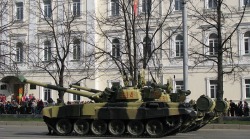
T-74 Main Battle Tank
The older T-74 main battle tank is being phased out of service with the Turkestani military. Built by Russia as an export variant of the more powerful T-81, the T-74 has seen service with most of the nations of the Riga Pact, including Turkestan, and several other countries around the world.
Turkestan has mostly replaced its own T-74s with the newer Timür tank. The T-74s that remain in service are those of auxiliary units, as well as T-74M bridging tanks and T-74R recovery tanks.
Turkestan has mostly replaced its own T-74s with the newer Timür tank. The T-74s that remain in service are those of auxiliary units, as well as T-74M bridging tanks and T-74R recovery tanks.
Timür
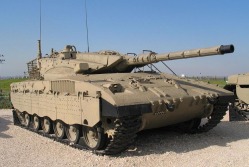
Timür Main Battle Tank
Turkestan's National Battle Tank project is the first of four "key strategic hardware" projects that in 1994 the Turkestani government announced its intention to self-build. The first of the new battle tanks entered service with the Turkestani Army and Guards in 2004 as the Timür ("Tamerlane") type Main Battle Tank. It replaced the aging Russian-built T-74 tanks with which they had been equipped; the outdated nature of this hardware show the critical need felt by Turkestan for a new model.
The speedy development from announcement of the project to full production can be attributed, at least in part, to the government putting their full weight and resources behind the project as a point of national pride.
While it has yet to be fully battle-tested in actual combat, the Timür appears a very capable machine, on a par with the Japanese "X-type" tanks in service in some parts of the world. The new battle tank is a source of great pride to the Turkestani military, and an even greater one has been the interest of other nations (notably Mongolia and Azerbaijan) in purchasing the Timür for ther own armed forces.
The speedy development from announcement of the project to full production can be attributed, at least in part, to the government putting their full weight and resources behind the project as a point of national pride.
While it has yet to be fully battle-tested in actual combat, the Timür appears a very capable machine, on a par with the Japanese "X-type" tanks in service in some parts of the world. The new battle tank is a source of great pride to the Turkestani military, and an even greater one has been the interest of other nations (notably Mongolia and Azerbaijan) in purchasing the Timür for ther own armed forces.
Çıņğıs
The Çıņğıs ("Genghis") is a heavy variant of the Timür main battle tank, and is currently in service with the Turkestani Guards. It is considerably slower and less manoeuvrable than the Timür, but carries almost 50% more armour and has a massive 9½ iliş (166mm) gun.
The Çıņğıs is considerably heavier than most tanks, and has been designed specifically for the Turkestani Guards as a mobile gun emplacement and tank destroyer, reviving a concept from the Second Great War and adapting it to Turkestani battle doctrine.
The Çıņğıs is considerably heavier than most tanks, and has been designed specifically for the Turkestani Guards as a mobile gun emplacement and tank destroyer, reviving a concept from the Second Great War and adapting it to Turkestani battle doctrine.
NBM-1
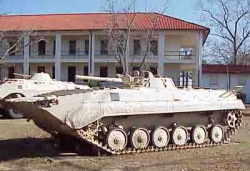
NBM-1 Infantry Fighting Vehicle
The Russian-made NBM-1 ("Новая Боевая Mашина") infantry fighting vehicle was already dated during its service in the Qaşgar War of 1991-1994, and is now almost obsolete. There are only a very few of these left in service in Turkestan, all with auxiliary units.
While most nations that used the NBM-1 have replaced their units with the NBM-2 model, or even the new Russian NBM-3, Turkestan, looking to diversify its military suppliers, decided to purchase the capable Shīr 2 light tank from Persia.
While most nations that used the NBM-1 have replaced their units with the NBM-2 model, or even the new Russian NBM-3, Turkestan, looking to diversify its military suppliers, decided to purchase the capable Shīr 2 light tank from Persia.
Shīr 2
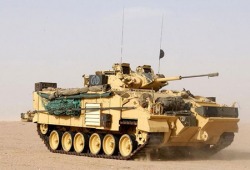
Shīr 2 Light Tank
The Shīr 2 is a Persian-built armoured vehicle in service with selected units of the Turkestani Army. It is an infantry fighting vehicle designed to provide armour capability to infantry units; in essence, a light tank which can carry a half squad of infantry. It was purchased as a stopgap measure to replace the outdated NBM-1s that were formerly in service while the Turkestani-made İskendir light tank was being developed.
İskendir
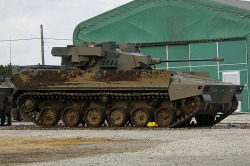
İskendir Light Tank
The İskendir ("Alexander") light tank is the newest unit in the increasing lineup of Turkestani-built armoured vehicles. It is something of a counterpart to the PBT(T) BattleCamel armoured personnel carrier, and is similar to the original, heavier specification that was cut for budgetary reasons during the development of that vehicle.
The İskendir light tank is only just being introduced in the Turkestani Army, and is intended to replace the outdated Russian NBM-1 infantry fighting vehicles and the Persian Shīr 2 purchased as a stopgap during the development of the İskendir.
The İskendir light tank is only just being introduced in the Turkestani Army, and is intended to replace the outdated Russian NBM-1 infantry fighting vehicles and the Persian Shīr 2 purchased as a stopgap during the development of the İskendir.
PBT(T) Çoğstüyü

PBT(T) Çoğstüyü Armoured Personnel Carrier
The need for a new armoured personnel carrier to replace the Turkestani Army's old Russian PBT-3s was evident in the wake of the 1991-1994 war with Uyguristan, in which Uyguristan's NBM-2 infantry fighting vehicles made short work of the older, simpler armoured personnel carriers used by Turkestan, and following the end of the war, the Turkestani government announced the development of a new APC as one of 4 "Key National Defence Projects".
However, budgetary overruns in the development of the Timur Main Battle Tank and T-9 Boran jet fighter meant that the budget for the new APC was slashed part-way to completion, and instead of the expected hyper-capable mini-tank for the infantry, the new armoured personnel carrier was to be done as cheaply as possible, while still incorporating every possible advance over the old PBT-3.
However, budgetary overruns in the development of the Timur Main Battle Tank and T-9 Boran jet fighter meant that the budget for the new APC was slashed part-way to completion, and instead of the expected hyper-capable mini-tank for the infantry, the new armoured personnel carrier was to be done as cheaply as possible, while still incorporating every possible advance over the old PBT-3.
The resultant PBT(T) Çoğstüyü ("BattleCamel") is heavily based on the older Russian PBT (Пежикная Бронетранспортр" series, as evidenced by the adapted designation. It utilises improved armour technology and an upgraded engine, but is still very much a member of the PBT family. It can, on the other hand, comfortably transport a full squad of soldiers (as opposed to the half squad managed by the NBM series, and has an increased armament, carrying two attack rocket tubes as well as the 2 3/4 iliş (48mm) espingol cannon.
